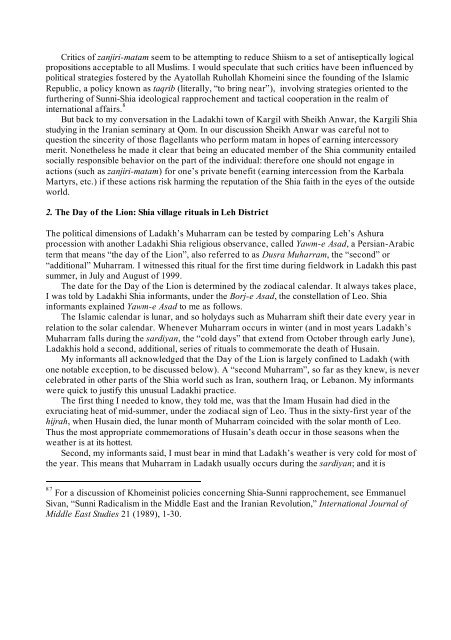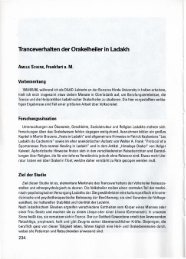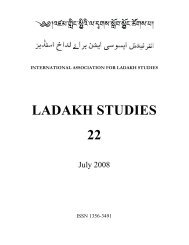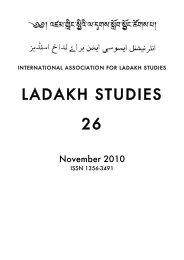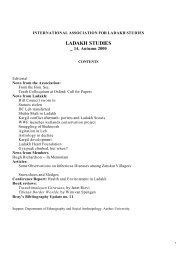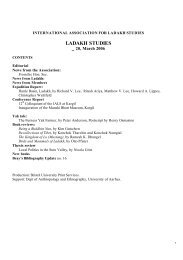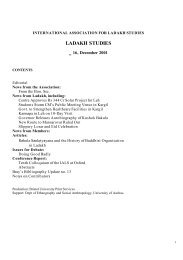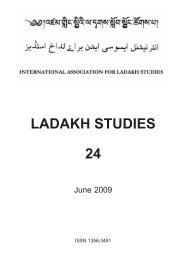LADAKH STUDIES 12, Autumn 1999 - International Association for ...
LADAKH STUDIES 12, Autumn 1999 - International Association for ...
LADAKH STUDIES 12, Autumn 1999 - International Association for ...
Create successful ePaper yourself
Turn your PDF publications into a flip-book with our unique Google optimized e-Paper software.
Critics of zanjiri-matam seem to be attempting to reduce Shiism to a set of antiseptically logical<br />
propositions acceptable to all Muslims. I would speculate that such critics have been influenced by<br />
political strategies fostered by the Ayatollah Ruhollah Khomeini since the founding of the Islamic<br />
Republic, a policy known as taqrib (literally, “to bring near”), involving strategies oriented to the<br />
furthering of Sunni-Shia ideological rapprochement and tactical cooperation in the realm of<br />
international affairs. 8<br />
But back to my conversation in the Ladakhi town of Kargil with Sheikh Anwar, the Kargili Shia<br />
studying in the Iranian seminary at Qom. In our discussion Sheikh Anwar was careful not to<br />
question the sincerity of those flagellants who per<strong>for</strong>m matam in hopes of earning intercessory<br />
merit. Nonetheless he made it clear that being an educated member of the Shia community entailed<br />
socially responsible behavior on the part of the individual: there<strong>for</strong>e one should not engage in<br />
actions (such as zanjiri-matam) <strong>for</strong> one’s private benefit (earning intercession from the Karbala<br />
Martyrs, etc.) if these actions risk harming the reputation of the Shia faith in the eyes of the outside<br />
world.<br />
2. The Day of the Lion: Shia village rituals in Leh District<br />
The political dimensions of Ladakh’s Muharram can be tested by comparing Leh’s Ashura<br />
procession with another Ladakhi Shia religious observance, called Yawm-e Asad, a Persian-Arabic<br />
term that means “the day of the Lion”, also referred to as Dusra Muharram, the “second” or<br />
“additional” Muharram. I witnessed this ritual <strong>for</strong> the first time during fieldwork in Ladakh this past<br />
summer, in July and August of <strong>1999</strong>.<br />
The date <strong>for</strong> the Day of the Lion is determined by the zodiacal calendar. It always takes place,<br />
I was told by Ladakhi Shia in<strong>for</strong>mants, under the Borj-e Asad, the constellation of Leo. Shia<br />
in<strong>for</strong>mants explained Yawm-e Asad to me as follows.<br />
The Islamic calendar is lunar, and so holydays such as Muharram shift their date every year in<br />
relation to the solar calendar. Whenever Muharram occurs in winter (and in most years Ladakh’s<br />
Muharram falls during the sardiyan, the “cold days” that extend from October through early June),<br />
Ladakhis hold a second, additional, series of rituals to commemorate the death of Husain.<br />
My in<strong>for</strong>mants all acknowledged that the Day of the Lion is largely confined to Ladakh (with<br />
one notable exception, to be discussed below). A “second Muharram”, so far as they knew, is never<br />
celebrated in other parts of the Shia world such as Iran, southern Iraq, or Lebanon. My in<strong>for</strong>mants<br />
were quick to justify this unusual Ladakhi practice.<br />
The first thing I needed to know, they told me, was that the Imam Husain had died in the<br />
exruciating heat of mid-summer, under the zodiacal sign of Leo. Thus in the sixty-first year of the<br />
hijrah, when Husain died, the lunar month of Muharram coincided with the solar month of Leo.<br />
Thus the most appropriate commemorations of Husain’s death occur in those seasons when the<br />
weather is at its hottest.<br />
Second, my in<strong>for</strong>mants said, I must bear in mind that Ladakh’s weather is very cold <strong>for</strong> most of<br />
the year. This means that Muharram in Ladakh usually occurs during the sardiyan; and it is<br />
8 7 For a discussion of Khomeinist policies concerning Shia-Sunni rapprochement, see Emmanuel<br />
Sivan, “Sunni Radicalism in the Middle East and the Iranian Revolution,” <strong>International</strong> Journal of<br />
Middle East Studies 21 (1989), 1-30.<br />
24


